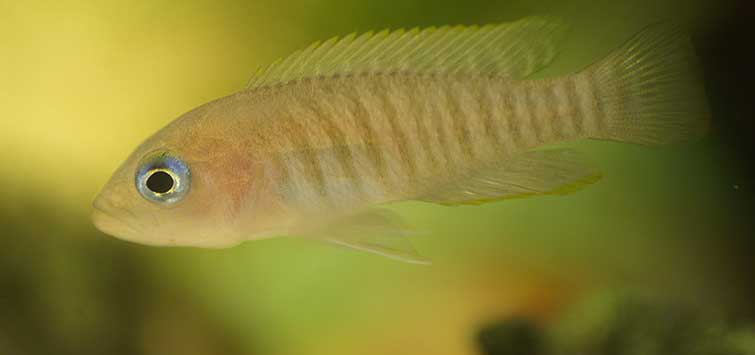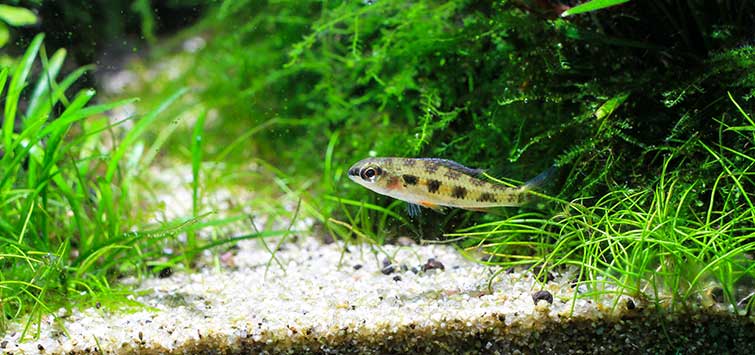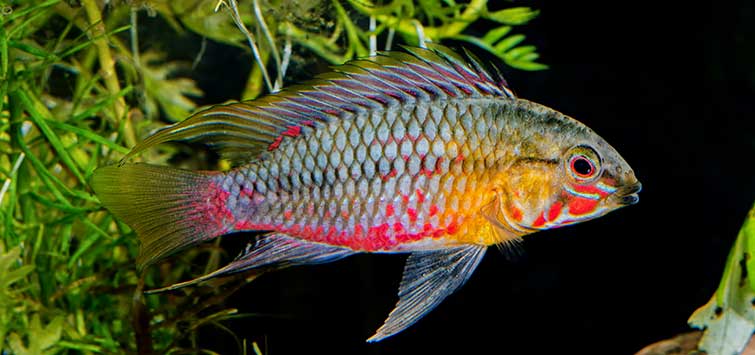The Best Dwarf Cichlid for the Beginner
Author: Marie Flanigan
The small, shell-dwelling multis from Lake Tanganyika are perfect for hobbyists who want to observe fascinating cichlid behaviors without dealing with large sizes or bad attitudes.
Cichlids are well known for their interesting behavior, and they generally make great aquarium inhabitants. Unfortunately, many cichlids are large fish with complex territorial interactions. They often require large aquariums with expensive rock arrangements to keep them from harming each other, making them impractical for many aquarists. Neolamprologus multifasciatus are the smallest cichlids and the easiest to keep if you have limited space but still want to experience fascinating cichlid behavior. These tiny shell dwellers live in colonies and are a joy to keep.
Natural Habitat
N. multifasciatus are native to the world’s longest lake, Lake Tanganyika, located in East Africa’s Great Rift Valley. These tiny fish have dark-gray vertical stripes on a cream-colored body with gray fins. They make their homes in the discarded shells of Neothauma tanganyicense, a freshwater snail also found in the lake. The lake floor is sandy, and the water is very hard. Multis live in relatively peaceful shell colonies, which is one of the reasons they are so easy to keep in the home aquarium.
Aquarium Care
Water Requirements
Multis need water temperatures of 75° to 81°F with a pH of 7.8 to 9.0, and the water should be hard. They also need a sandy substrate and plenty of shells. Males can be up to 2 inches in length. Females are smaller at about an inch. A 10- or 20-gallon aquarium is sufficient for their needs.
Living Space
My colony is kept in a 20-gallon high tank. Like many other cichlids, they do better when they are a little overcrowded. Due to their small size and shy nature, they do not compete well for food, especially with other larger cichlids, so they are best kept in a species tank.
Lighting
I use full-spectrum florescent lights and a nutrient-rich plant substrate, which suits their need for a small-grain substrate and also allows me to plant Java fern and Cryptocoryne wendtii. Both plants are hardy enough to handle the basic pH, and C. multifasciatus have no interest in eating them.
Plants
Over time the hardness of the water will deteriorate the leaves of the Java fern, but I still like to add plants to a cichlid aquarium. In addition to making it look nice, they will help maintain the water quality. I pull any leaves that have eroded whenever I do a water change. The plants continue to produce new growth despite the harsh conditions.
However, if you want to have a more authentic-looking natural tank, you should use aquarium sand and leave out the plants. Regardless of what small-grain substrate you choose, make sure it is at least 2 inches deep—these little fish are diggers. If you don’t have enough substrate, they will leave bare patches on the bottom of your tank.
Hiding Places
To provide hiding places, I purchase escargot shells from my grocery store and rinse them in aquarium water before sinking them in the tank. Any store that has a gourmet food section is likely to have escargot shells, and they make great homes for the multifasciatus.
You can also use empty shells from apple snails or mystery snails that you may find at your local fish shop, but sometimes these are quite small. Hermit crab shells or even small sea shells that you pick up at the shore would work provided you clean them very well in aquarium water before use.
I prefer escargot shells because they are big, which makes it easier to see when there are fry in the shell opening. There is no need to arrange the shells in any specific way in the tank because the fish won’t leave them where you put them anyway. If you cannot find adequate shells, small PVC elbows will do, but cap one end to make them more shell-like.
Behavior
Perhaps the best reason to keep multifasciatus is to watch their fascinating antics. They are very particular about their environment and are constantly sculpting it to suit their needs. They dig by scooping up mouthfuls of substrate and then spitting it out. They can completely change the landscape of a tank overnight.
Shells
Unlike other shell dwellers, N. multifasciatus don’t bury their home shells, but they push them and move them around. They dig so much in the substrate that any spare shells in the tank often end up completely buried. Their constant digging is why it is so important to use a small-grain substrate.
Territories
Males establish territories, very tiny territories to be sure, but territories nonetheless. At my house, 6 p.m. is territorial dispute time. At around that time every evening, the males will put on territorial displays. They swim around each other, chase each other, and occasionally even lock jaws. I have never lost a fish or even had one injured during this kind of behavior, but presumably it could happen considering they have very sharp teeth.
Sharing with Snails
My multifasciatus share the tank with Malaysian trumpet snails. The males do not like the snails venturing into their territories. If a snail gets on one of the multifasciatus home shells, a large male will pull the trumpet snail off and swim it to the other side of the aquarium and drop it. This is not an insignificant feat, since some of the trumpet snails are almost as big as the cichlids. Of course, the most famous behavior of these small fish is their fast escape into the shells. It’s amazing how quickly they can all disappear when startled, leaving what appears to be an empty tank.
Feeding
N. multifasciatus are not picky eaters. In the wild they eat predominantly small invertebrates, but they will eat just about anything in the home aquarium. For a basic maintenance diet, I use a staple granule. The males will eat at the surface but dominate the females there, so I prefer sinking granules. They seem to give the females more opportunities to feed without having to compete so much with the larger males.
Multis will also eat live or frozen foods, such as bloodworms and brine shrimp, but these aren’t necessary unless you are trying to get them to breed. If you provide a piece of food much too big for them to eat, the little cichlids will attack in a pack, tearing the meat to pieces. When they are feeding this way, you can really see the potential of those very sharp teeth. Within a few minutes, all the food will be gone.
Breeding
Getting N. multifasciatus to breed is not difficult. All that is required is a male, a female, a shell, and high-quality fresh or frozen food. I use frozen baby brine shrimp. My starter colony of six multifasciatus grew to thirty very quickly.
When I want to slow down their breeding due to aquarium size constraints, I just stop the brine shrimp and go back to the granules. You will still see occasional fry, but not nearly as often. It is as simple as that.
N. multifasciatus lay their eggs in the shells so you will not know if breeding has been successful until you see the tiny fry appear at the mouth of the shell. Like most cichlids, multifasciatus make good parents. They protect their young and stand guard at the mouth of their shells when they have a brood. The tiny females do not have large broods. Since they lay their eggs inside the shell, it is difficult to tell if the small broods are due to not laying many eggs or a low rate of egg viability. A typical brood in my tank consists of three to six fry. The fry stay very close to the shell until they are over a centimeter long but even then, like all multifasciatus, they do not venture far from home.
A Great Little Fish
Whether you are new to the aquarium hobby, new to cichlids, or experienced with both, give these little guys a try. They are simple to keep and fascinating to watch. They may not have the flashy colors of some of the larger cichlids, but they more than make up for that in charm.
See the full article on TFH Digital http://www.tfhdigital.com/tfh/201105#pg77

.png?h=595&iar=0&w=2781&hash=5FD5E69473BCC22199FBFA2FB71B6033)



